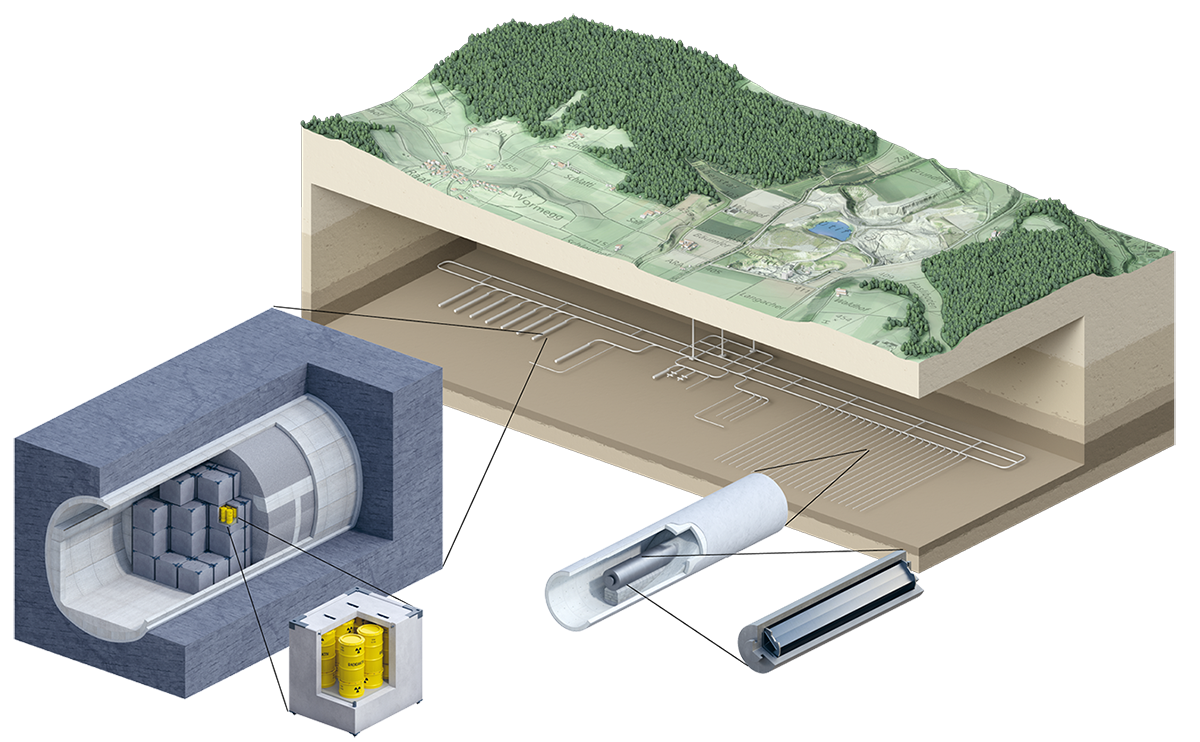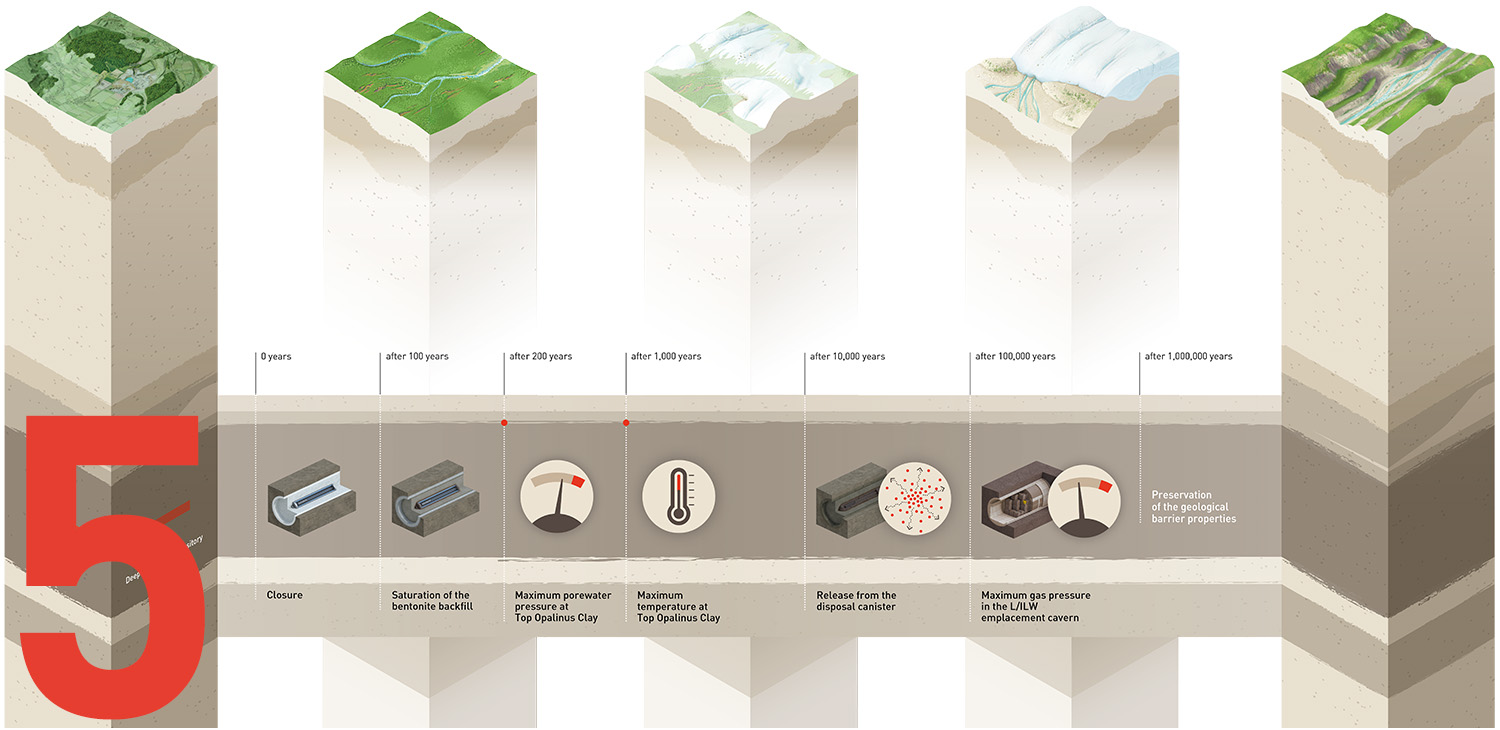A safety case must be provided for the operational and post-closure phases of the repository before a general licence can be issued. To confirm the earlier, approved demonstration of disposal feasibility, the changes to the project since its approval must be taken into account. For example, the expected pdf waste volume(96.93 MB) has decreased due to changes in the legal framework and progress in waste conditioning.
For Stage 3 of the Sectoral Plan, the Opalinus Clay was determined to be the most suitable host rock in Switzerland for all waste categories. With Stage 3, Nördlich Lägern has proven to be the most suitable siting region for both repository types and offers more than sufficient space, which is why Nagra is planning a combined repository for all waste categories. The main features of the repository concept remain largely unchanged. The multi-barrier system, which consists of the engineered and geological barriers, and the selected site provide robust arguments for demonstrating post-closure safety (argument report as per pdf ENSI 33/649(1.39 MB) ).
THE ENGINEERED BARRIERS
The properties of the engineered barriers of the repository delay the release of radionuclides and restrict their transport into the surrounding rock. Waste can only be emplaced in a repository in solid, stabilised and packaged form. Both spent fuel and vitrified HLW decompose very slowly in the repository. This also applies to L/ILW, which is fixed in a solid matrix, usually as glass, cement or bitumen.
In the HLW repository section, the disposal canisters ensure that the radionuclides remain confined for a significantly longer period than the 1,000 years stipulated by ENSI. As a result, most of the radioactive substances will decay while the disposal canisters are still intact, thus ensuring complete containment.
In the L/ILW repository section, the waste will be packaged into thick-walled concrete containers, and the remaining voids will be filled with mortar. In line with the current disposal concept, the bentonite intended for backfilling the HLW emplacement drifts up to the last voids, has similar properties to the Opalinus Clay.
Should cracks occur, it can self-seal, and it has a very low permeability. Most radionuclides sorb very well on bentonite. As a result, further radionuclides will decay before they can pass through the bentonite. Finally, the sealing and backfilling of the accesses to the deep geological repository ensure further retention of the radionuclides.
THE OPALINUS CLAY
The most important barrier of the repository is the geological barrier. Its transport and retention mechanisms ensure the retention and very slow release of radionuclides due to the high proportion of clay minerals. In particular, the safety-relevant properties of the Opalinus Clay include:
- low permeability for water and gas, which ensures that radionuclide transport takes place mainly by diffusion, i.e. a slow equalisation of a concentration gradient without the involvement of flowing water.
- negative charge of the clay minerals and their large surface area, which ensure that positively charged radionuclides are bound to and retained by the clay minerals (sorption).
- the swelling capacity, which seals cracks in the rocks (self-sealing), so that the low permeability for water and gas remains ensured in the long term.

Multi-barrier concept of the deep geological repository (2024).
THE SITE
Finally, the features of the site where the Opalinus Clay is located at a suitable depth are of central importance for post-closure safety:
- The extent of the layer of Opalinus Clay is more than sufficient.
- The long-term stability of the safety-relevant properties is ensured thanks to the geologically stable situation.
Extensive knowledge of the comparatively uneventful geological history of Northern Switzerland is a prerequisite for making reliable assumptions about the likelihood of future changes. Past time periods that are around one hundred times longer than the period for assessment for the deep geological repository are clearly understood. The 174-million-year-old Opalinus Clay is around 100 metres thick and was deposited in a vast, shallow sea over the – geologically short – time period of one to two million years.
Understanding erosion processes is important because Northern Switzerland will uplift in the long term and erode subsequently. The retention properties of the geological barrier will not be impaired by decompaction and weathering as long as the clayrich rocks do not come too close to the surface, i.e remain at a depth of more than 200 metres. The disposal level at the site lies at a depth of 800 to 900 metres.
The uplift rate expected in the long term, an isostatic levelling movement caused by the formation of the Alps, is less than 3 tenths of a millimetre per year. Assuming constant uplift rates, an uplift of less than 300 metres can be expected over the next one million years. In addition to uplift and erosion by rivers, potential future glacial advances and the varying erosion resistance of the different rock layers are also taken into account in the safety analyses of potential impacts of future evolution.
As the assessment of future barrier properties always considers bounding variants with cautious (conservative) assumptions, i.e. also with unfavourable assumptions regarding future uplift and erosion rates, the predictions always include safety margins. Even taking all aspects into account, the long-term preservation of barrier properties has large safety margins.
The analysis of the groundwater and porewater allows predictions to be made about the transport processes in the geological barrier. The porewater compositions analysed along boreholes in combination with the composition of the deep groundwaters confirm the retention capacity of the rocks. The exchange processes between groundwater and porewater mainly take place by diffusion and over very long periods of time.
The safety analyses also include conservative assumptions about the hydrogeological release pathways. Above the disposal level, the nearest aquifer is located at a depth of around 400 metres.
The age of the groundwater in the aquifer has been determined to be several hundred thousand years. This is a significant isolation period. Nonetheless, the assumption for the safety analyses is that, once radionuclides have reached the aquifer, they will then reach the earth’s surface directly and without delay.
In this way, the potential radiological impacts of a deep geological repository are calculated based on the most conservative assumptions to take into account any remaining uncertainties.
The evolution of the engineered barriers, geological barriers, the biosphere and people’s living habits can each be predicted differently with regard to time. The long-term behaviour at the disposal level is known from many years of research and can be well predicted using model analyses. At the beginning of the post-closure phase, during which the containment of the HLW in the disposal canisters is ensured, heat is generated by the radioactive decay of the waste.
When designing the repository, it must be verified that the rise in temperature does not impair barrier properties. A rise in temperature causes a change in pressure conditions, which are additionally influenced by gas produced by the corrosion of metals. Gas is also produced in the L/ILW repository section through the corrosion of metals and the decomposition of organic waste. This gas is distributed throughout the backfilled infrastructure at disposal level.
System analyses confirm that the gas storage volume of the planned backfill materials will be sufficient to ensure that the gas pressure in the repository will remain below the critical values and that the mechanical integrity of the geological barrier will remain ensured with a sufficient safety margin.
The uncertainties at the earth’s surface with regard to climate evolution and human behaviour are taken into account in the safety analyses by means of bandwidths and unfavourable assumptions. The results are measured against the specification of the maximum permissible additional individual dose of 1 mSv per year from the deep geological repository, demonstrating that safety can be ensured for the wide spectrum of scenarios considered.
In all cases, the resulting maximum individual dose remains below the protection criterion, in most cases by several orders of magnitude. To demonstrate the robustness of the multi-barrier system, hypothetical evolution scenarios are also analysed. The system is shown to remain robust even in the event of these impossible scenarios. The knowledge gained since the demonstration of disposal feasibility with regard to the performance of the engineered and geological barriers has led to a more robust safety case.
The extensive geoscientific investigations carried out during the Sectoral Plan process have further substantiated the safety cases. For example, the contribution to the barrier function of the low-permeability confining geological units over- and underlying the Opalinus Clay can also be taken into account. The surface facility can also be designed in such a way that it can withstand all hazards during the operational phase and protect the surrounding area, population and workers from unauthorised radiation exposure.

